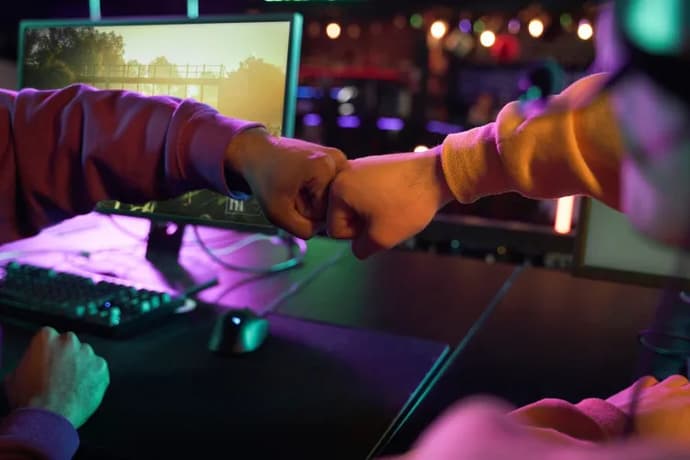
The History of Esports: When was created and How It Has Changed Competitive Gaming

What we know as esports today started a long time ago as competitive gaming. In 1972, home consoles were all we ever had and moving on from there, the gaming industry introduced several innovations that paved the way for tournaments such as the League of Legends World.
With predicted earnings of $4.3 billion and viewership in several millions for major events, esports have clearly made an impact on a worldwide scale. As the industry expands, there's an overwhelming number of new career options that go well beyond the realm of gaming tournaments.
While the skill of today's top professional gamers deserves recognition, the community thrives by the dedication of countless others who work tirelessly behind the scenes. In this post, expert Kate Richardson, a tipster from MightyTips has been actively following the esports industry and confirms that the industry is on the rise, so much so that betting on esports games has become a popular option for fans.
As internet speed and availability improves, the popularity of online video games and competitive gaming keeps increasing. Platforms like MightyTips have also been contributing to the popularity of esports betting through daily updates from betting sites. With that, more people can bet on their favorite teams and make a lot of money while at it.
That said, this article details all you need to know about the history of esports and how it has changed competitive gaming.
From The 50s To Today: How Did Esports Start?
The first recorded instances of competitive console game play date all the way back to 1952. That was when computer scientist Alexander Douglas Shafto began working on his dissertation. His thesis was centered on how humans interact online with computers.
While at it, he had the brilliant idea of making the XOX game PC-compatible. But unfortunately, this only allowed human players to compete against computers, and the human would always have to decide who got the ball rolling.
In 1958, the first video game (Tennis for Two) was played and it allowed people to compete against one another. To control the ball's trajectory and hit it, players used an early version of the joystick in the game.
According to several experts, this title was the first game and the major catalyst that led to the development of esports.
The First Esports Games created
The 1960s were a formative decade for electronic sports, even though no official video game competition or esports tournaments were held at the time. Back in 1962, people played 'Spacewar' on PDP-10 computers. It was the brainchild of a group of MIT computer scientists led by Steve Russel.
To play, participants matched against each other using their individual spaceships. Each player's spaceship faced the planet's gravity field head-on with just a limited supply of fuel and ammunition.
Many believed this game was the first computer-based game and it ranked high among the most significant games throughout history. Ten more years would pass before spacewar ever hosted a tournament. Yet, this easily passes as the world's first esports competition.
Instead of the regular cash prizes, the winning esports team were given a year's access to the Rolling Stones Magazine.
Fast forward to 1978, Atari introduced the digital game title, Space Invaders, which eventually ushered in the first major esports tournament. The game became quite popular and inspired the Space Invaders Championship a year later.
In 1988, Netrek came as the first online team game/multiplayer online battle arena (MOBA). The 90s introduced large national gaming competitions plus a better access to online competitive multiplayer games.
A Decisive Turning Point in the History of Esports and Traditional Sports Gaming
As internet speed and availability improved in the 2000s, the popularity of online video games and PC gaming skyrocketed. Websites like MightyTips help gamers enjoy seamless gameplay and connect with others worldwide.
Besides, gaming PCs became more accessible, and more players were able to stream popular esports games like League of Legends, Street Fighter, and Super Mario Bros. Nintendo took advantage of this and launched the NWC (Nintendo World Championships) in 1990.
Among other things, ‘Evo Moment #37’—the match between Daigo Umehara and Justin Wong at the 2004 Evolution Championship series—may have been the most memorable moment in competitive gaming history. Surprisingly, Umehara managed to parry fifteen consecutive attacks with just one health pixel left.
In 2002, MLG (Major League Gaming) was introduced (shortly after the Electronic Sports World Cup and World Cyber Games debuted) and it became the first ever video game console gaming league to be televised. Halo 2 Pro Series featured as one of their most renowned esports events in 2006.
With firms like FUN Technologies hosting world championship tournaments with $1 million cash prize for the grand winner, esports continued to grow in popularity. The idea of video game tournaments was further cemented after the release of the initial Tron movie.
In 2013, the US officially acknowledged all esports players as professional athletes, granting entry to those from other countries that met the necessary visa requirements.
Esports and traditional sports share so many things in common, and it definitely doesn't surprise us that esports has become a popular trend among game lovers.
What Makes Esports Popular?
Though competitive gaming has been around for a long time, there's no denying that the rise of esports has changed the face of online gaming. The following are reasons why the video game competition seems to be more popular across nations:
Competitive Gaming Among Esports Players

Fans enjoy watching and competing in esports for many reasons, but the thrill of competition is one of the most important. Like in most other sports, players put in their best just to make sure they win. And in the words of investor Mark Cuban, ‘Competition is the best thing that’s ever happened to sports betting.’ It's part of the ecosystem that contributes to esports growing popularity.
Anyone Can Watch Professional Esports Gamers Play from Anywhere in the World
With esports, it's easy to follow a particular team or player and become a fan. Live streaming platforms like YouTube and Twitch allow anyone to watch esports pros compete from anywhere across the globe.
From League of Legends to Super Smash Bros, There Are Several Game Options Available to a Pro Gamer
Another reason why esports is popular is the variety of games available to players. Whatever your taste, you'll find a gaming title that can keep you in high spirits.
Esports Competitions Are an Opportunity for People to Socialize with Others in the Gaming Industry
Nowadays, players from all around the world can connect with one another through online video games. This means that users can jump right in, start playing, and build friendships with other players in the digital gaming arena.
The Quality of Video Games Has Greatly Improved
In terms of general quality, modern video games are light years ahead of their 2D predecessors. Many creators have worked tirelessly to enhance the games' visuals and performance for professional gaming.
Countries with the Highest Number of Professional Esports Players
According to tech expert Jensen Huang, ‘Esports is the fastest-growing sport in the world, and it’s becoming a major part of the entertainment industry.’
Below are some of the countries with the highest number of gamers in esports history:
- South Korea
- China
- Denmark
- USA
- Sweden
The Rise of Competitive Online Gaming: Future Trends in the World of Esports
In the coming years, we expect to see some of the following trends in esports that'll ultimately impact the world of competitive video gaming:
The Expansion of Mobile Game Play
Video games such as PlayerUnknown's Battlegrounds Mobile and Arena of Valor are at the forefront of the mobile gaming boom in the cybersports industry. By allowing a wider audience to play and watch the games, mobile devices have greatly increased interest in esports.
Virtual Reality (VR) and Augmented Reality (AR)
Emerging technologies like virtual reality (VR) and augmented reality (AR) have great promise for electronic sports. They can deliver more intuitive experiences for gamers and viewers. And ultimately, they alter how competitive esports are played and enjoyed.
Can Cybersports Become an Olympic Sport?
Certainly. In 2025, Saudi Arabia (which recently became a hub of esports) will play home to the first-ever Cybersport Olympics—thanks to a partnership between the International Olympic Committee and the Saudi Arabian National Olympic Committee.
The decision was made partly due to the popularity of esports organizations across the world. It came after the International Olympic Committee recently announced that a cybersport Olympic Games would be hosted.
A Career as a Cyber Athlete: Is It Worth It?
Yes. And as a matter of fact, now's just the best time anyone can join the esports industry. The potential for earning in cybersecurity roles particularly makes it worth the time and effort.
As cyber crimes and cyber threats increase these days, there's a growing need for the employment of cybersecurity experts. The opportunities available to specialists are diverse, and there's a lot they can achieve with their expertise.
As a security architect, penetration tester, an esports coach, or engineer, you can expect a steady increase in demand for services. This definitely would mean some more money for you at the end of the month. And if you will, you can have your own esports arena or an esports team at your school.

Elen Stelmakh er en kreativ person som er opptatt av å fremme spillkulturen gjennom artikler og visuell design. Som heltidsansatt EGamersWorld-forfatter og designer for et spillnettsted skaper Elen ikke bare innhold, men tilfører det også energi og kreativitet.
 Mystbloom 2.0 Bundle Detaljer: Liste over alle skins, pris, utgivelsesdato, utseende i spilletMystbloom 2.0 viderefører blomster- / "bloom"-temaet, og beholder de kronbladlignende formene og den sesongbaserte fargepaletten som definerte den første kolleksjonen.
Mystbloom 2.0 Bundle Detaljer: Liste over alle skins, pris, utgivelsesdato, utseende i spilletMystbloom 2.0 viderefører blomster- / "bloom"-temaet, og beholder de kronbladlignende formene og den sesongbaserte fargepaletten som definerte den første kolleksjonen. Oversikt over Dota 2 DreamLeague sesong 27Oppdag alt om DreamLeague sesong 27: tidsplan, format, deltakende lag og premiepotten på 1 000 000 dollar.
Oversikt over Dota 2 DreamLeague sesong 27Oppdag alt om DreamLeague sesong 27: tidsplan, format, deltakende lag og premiepotten på 1 000 000 dollar. Når kommer den nye ARC Raiders-sesongen ut?Cold Snap bringer vinterkart, nye fiender og et oppfrisket Raider Deck til ARC Raiders i desember.
Når kommer den nye ARC Raiders-sesongen ut?Cold Snap bringer vinterkart, nye fiender og et oppfrisket Raider Deck til ARC Raiders i desember. Dreglord: Nightreign Ny Boss GuideDreglord er Nightreigns mest straffende fiende, og krever presise bevegelser, kontrollert aggresjon og en kroppsbygning som er innstilt på press under kaotiske forhold.
Dreglord: Nightreign Ny Boss GuideDreglord er Nightreigns mest straffende fiende, og krever presise bevegelser, kontrollert aggresjon og en kroppsbygning som er innstilt på press under kaotiske forhold.


